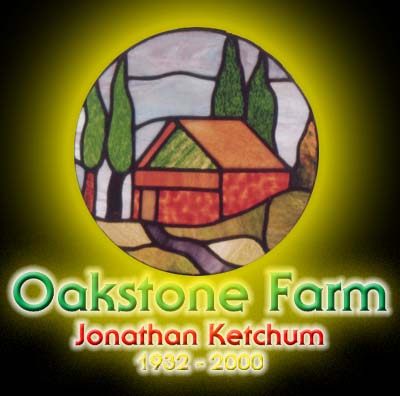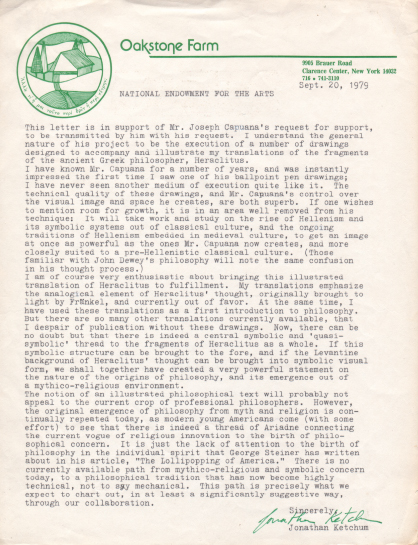I first met Jonathan Ketchum during my sophomore year at SUNY at Buffalo. One of Jon's flyers advertising the Oakstone Farm caught my eye, and I was intrigued. During that time, I was having a very difficult time academically in the Art Department. I entered art school to learn techniques of drawing and painting. However, the orientation of the department was primarily towards experimental and so-called "cutting-edge" art forms. So, was really out of place with my portraits and landscapes. One professor chastised me because I utilized a ballpoint pen as an art instrument. When I mentioned it to Jon he advised: "Take this as an example, if someone tells you that you cannot draw with a ballpoint pen. Just remember, that Sansa, who was a great stuffy composer of the 19th century walked out of the first performance of Stavinsky's Right of Spring after about 12 measures saying, 'Bassoons don't play that high!' Well, it's plain that the bassoons were playing that high." I appreciated Jon because he understood what I was doing and was able to impart many valuable aspects of cultural history which I otherwise would not have been aware of.
Jon operated Oakstone Farm, in Clarence Center, New York, and a student residence, which attempted to combine a communal lifestyle with rigorous philosophical inquiry and study. The Oakstone Farm was located in a 5,000 square foot renovated century-old house on a multi-acre farm at 9905 Brauer Road.
The following summer, I decided to give the Oakstone Farm experience a try and became a resident for several months. The rugged physical beauty of the Farm was impressive. Hard woodfloors, brick fireplaces and wooden ceiling pillars. An extensive classical music library, state-of-the-art (at that time) stereo system, 15 rooms and a library stocked with well-over 7,000 volumes occupied an entire wing of the house. For my self, library was by far its most impressive room. It was the most extensive and well-organized personal library I have ever seen. I spent much of my free time at the farm in the library mostly studying the art books. Outside were two barns; an older gray barn used for storage, and newer red barn the upstairs had been renovated into a gym. In one of the lower rooms was a music room complete with baby grand piano and harpsichord, the other agecent room was an auto shop. In the back yard of the farm was a one-acre pond, which was used for swimming, ice skating and sometimes fishing. There was also a kiln which one of the residents had built..
At the communal dinner at 5:00 p.m. every night one was expected to participate in the philosophical discussion which took place often lasting well into the evening. Occasionally, we had students or faculty guests from SUNY at Buffalo or Canisius College. On Sunday night, we all attended the weekly seminar. The short time I was out there, we studied the Pre-Socratic philosophers: Heraclitus, Parmenides and several of the Platonic dialogues. To be honest, much of the weighty academics were way over my head, but I was still interested.
During the early eighties, as students became more career oriented, interest in philosophy and scholarship waned. The ideal of Oakstone Farm eventually withered from a lack of interest.
Jon sold the Oakstone Farm, became a computer programmer and moved on Shimmerville Road in Clarence. I continued my friendship with Jon over the years we would communicate sporadically. I was greatly disturbed by the knowlege of his passing. He was a good friend to me and geneously gave guidance too many students. He is greatly missed.
-- Joseph Capuana



